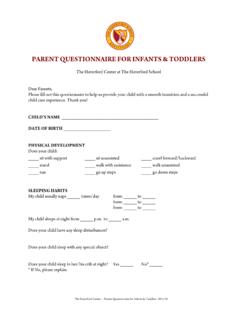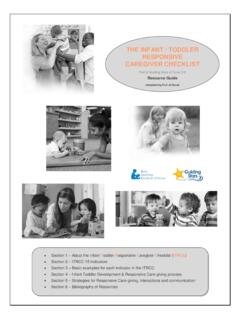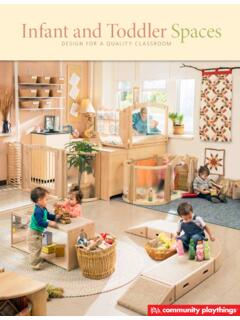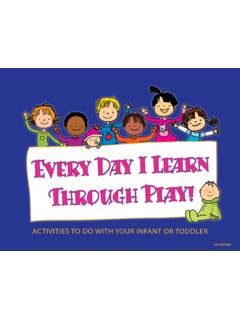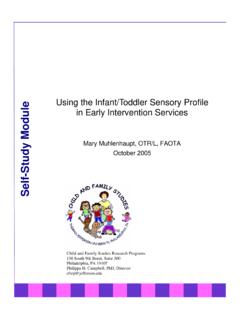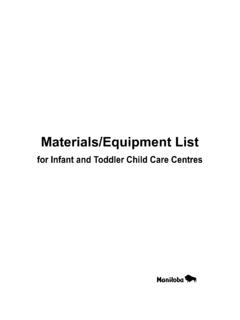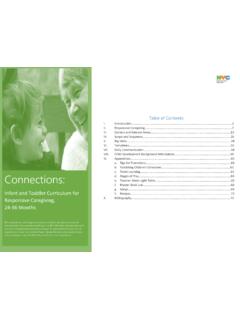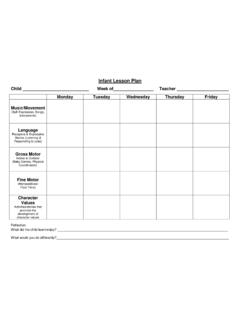Transcription of Montessori Infant/Toddler Curriculum (6 weeks to 2 1/2 ...
1 Montessori Infant/Toddler Curriculum (6 weeks to 2 1/2 years of age). Infant/Toddler Program Benefits Our Montessori based toddler Curriculum supports the physical, cognitive, social and emotional development of each child. Toddlers strengthen, speech and language development and both fine and gross motor skills as they explore self, family, and the world in which they live. Learning the Montessori way is, literally, learning for life. The toddler program prepares the toddler class children for preschool work by exposing them to each area of Montessori Curriculum .
2 The toddlers learn concentration, coordination, language skills, responsibility, and respect all of which prepare them well for a successful transition into preschool in Inclusive Montessori . So What Is So Special About the Montessori Classroom? There are four main elements that distinguish it from other traditional classrooms: 1. All equipment is accessible to your child and is always available to the child. 2. Your child has freedom of movement both indoors and out as well as a choice of what to do for much of the day 3. Your child will have personal responsibility for their work; this requires an awareness of the needs of others, avoiding dangerous or hurtful actions, keeping the equipment and resources tidy, putting things away after using them, being good role models for younger children, developing a true social awareness.
3 4. Beauty and Harmony: This aspect is too often ignored by those who focus too much on the content of learning. Montessori felt strongly that the environment must be aesthetically pleasing to encourage learning and concentration. Too many displays can distract children if they are not properly related to their interests. It reflects the manner in which the Montessori classroom is calm and activities are self-directed. Language Curriculum The most important language materials for a toddler are the materials and experiences in the child's environment.
4 Reinforcing the importance of verbal communication, speaking clearly and supporting the child's expanding vocabulary are a daily process in the toddler environment. For a toddler written language is experienced through the adult's oral reading and story time. These activities revolve around four areas: Pre-reading Matching cards Vocabulary cards Stories read aloud Size and shape discrimination exercises Picture-word cards Matching Tracing objects Tracing shapes Word Recognition Sandpaper letters Isolating initial sounds Pre-writing Sandbox tracing Math Curriculum Maria Montessori believed that a child's mind is mathematical and based on the order and perceptual awareness found in the development of the senses.
5 The acquisition of mathematical principals is seem as developing logically form concrete to abstract and simple to complex. The child who has experienced basic concepts involved with the practical life and sensorial materials to progresses naturally to the beginning math activities. We make this enjoyable by providing these very day activities: Counting Activities (1-4 and 1-10). Develops the difference in dimension, width, length, and size can be found in these materials: Counting songs Counting fingers, animals, children, objects in the environment, etc.
6 Spindles boxes Sandpaper numerals Numeral sandbox tracing Concept of Time Daily routine Periods of the day (morning, afternoon, evening). Seasons Science Curriculum Science for the toddler means activities where the child can directly observe and manipulate physical properties. The tactile element is the key ingredient for learning about their world. Appropriate science activities for toddlers allow for the maximum child interaction and minimal adult intervention. These activities make a significant contribution to the child's development because they foster autonomous functioning.
7 When children can manipulate materials and equipment and discover on their own, they feel a great sense of mastery and positive satisfaction which helps build their self-concepts. It is extremely important to remember that it is the process not the product that is important and creates learning within the child. Life Science Plant care Animal care Nature walks Living v. nonliving Life cycles Physical Science Sink and float activities Gravity Magnetic v. nonmagnetic Color mixing Weight/balance Earth Science Water properties Weather/seasons Oceans Rocks Scientific Reasoning and Technology Observation Measures World Language: Spanish Curriculum The Spanish program is designed to enable students to speak and write their basic thoughts and questions in a second language.
8 The Curriculum utilizes a combination of speaking, writing, and activities that are often based on music, art or Total Physical Response. Students learn to express themselves in a second language environment that promotes confidence and creativity. toddler Classes Numbers Body parts Songs Animals Cultural Studies Curriculum Montessori schools presents a school-wide, three-year rotation of content so special events such as cultural festivals, assemblies, field trips, and reading lists can be thematically planned for the whole school. Each year, a central question is posed and each level has its own sub-questions that focus the capabilities.
9 The toddlers, who are in that environment for one or, perhaps, two years, may touch all three subjects in the course of a year. Year One: Ancient Civilizations The school-wide central question is How and why were ancient civilizations created? . The toddler focus is Where do we come from? Why do we tell stories? and Is every story about me? . Year Two: American Civilization The school-wide central question is How and why has American civilization created? . The toddler focus is How have I changed? What is family? What did my grandparents do when they were children?
10 And What does peace like? . Year Three: World Civilization The school-wide central question is How and why do world civilizations connect? . The toddler focus is Who am I? How am I the same or different from others? How many people are in the world? and What do they look like? . Practical Life Curriculum The practical life materials and exercises are designed to contribute to the development of both small and large motor skills and assist the child in becoming self-efficient and independent. Physical skills Control of movement Silence game Walking the line Respect and care of environment Squeezing a sponge Sweeping the floor Pouring grains and water Clamping clothespins Rolling a rug Using tools such as hammers and screwdrivers Opening and closing jar lids Opening and closing latches Using a strainer, beater, whisk Scrubbing a shell, rock, doll Caring for animals Recycling Grace, courtesy, and etiquette Greeting someone Please and Thank you.

